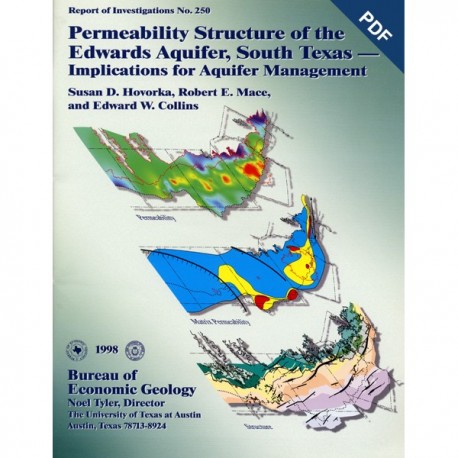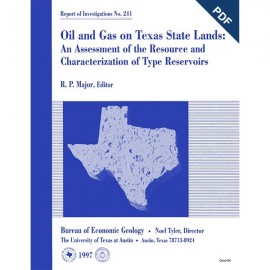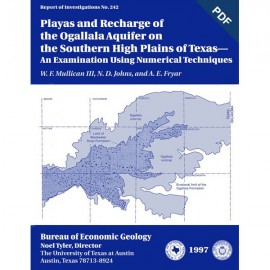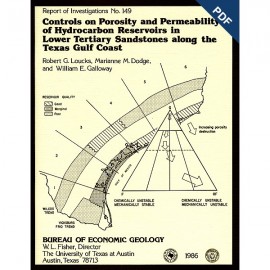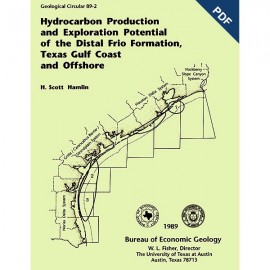Reports of Investigations
-
Books & Reports
- Reports of Investigations
- Guidebooks
- Udden Series
- Geological Circulars
- Down To Earth
- Atlases of Major Oil and Gas Reservoirs
- Texas Memorial Museum Publications
- Environmental Geologic Atlas of the Texas Coastal Zone
- Mineral Resource Circulars
- Other Reports
- Seminars and Workshops
- Handbooks
- Submerged Lands of Texas
- Symposia
- Annual Reports
- Open File Reports
-
Maps & Cross Sections
- Thematic Maps
- Miscellaneous Maps, Charts & Sections
- Geologic Atlas of Texas
- STATEMAP Project Maps
- Geologic Quadrangle Maps
- Cross Sections
- Highway Geology Map
- Energy and Mineral Resource Maps
- Shoreline Change and Other Posters
- Wilcox Group, East Texas, Geological / Hydrological Folios
- Bouguer Gravity Atlas of Texas
- River Basin Regional Studies
- Featured Maps
- Posters
- Teachers & the Public
-
Geological Society Publications
- Gulf Coast Association of Geological Societies
- Alabama Geological Society
- Austin Geological Society
- Corpus Christi Geological Society
- Houston Geological Society
- Lafayette Geological Society
- Mississippi Geological Society
- New Orleans Geological Society
- South Texas Geological Society
- GCS SEPM Publications
- Historic BEG & UT Series
Permeability Structure of the Edwards Aquifer, South Texas: Implications for Aquifer Management. Digital Download
RI0250D
For a print version: RI0250.
RI0250D. Permeability Structure of the Edwards Aquifer, South Texas: Implications for Aquifer Management, by S. D. Hovorka, R. E. Mace, and E. W. Collins. 55 p., 30 figs., 12 tables, 1998. doi.org/10.23867/RI0250D. Downloadable PDF.
To purchase this publication in book format, please order RI0250.
ABSTRACT
Quantitative and interpretive assessment of the three-dimensional distribution of permeability in the prolific, complex, and heterogeneous Edwards fractured karstic aquifer leads to improved understanding of the dynamic behavior of the aquifer and identifies areas where information is lacking. The study area comprises the Kinney to Comal County section of the aquifer, which supplies the city of San Antonio, Comal and San Marcos Springs, and agriculture. Techniques used in this study include analysis of specific-capacity tests; reinterpretation of research-well results; stratigraphic and porosity interpretation of wireline logs; core, core-plug, and thin-section analysis; subsurface and outcrop mapping; and quantitative analysis of outcrop analogs of the aquifer
Permeability in the Edwards aquifer varies over eight orders of magnitude, and it is multimodal. Multimodal permeability distribution implies that the fastest moving water can travel many times faster than the largest volume of water. This distribution is important to aquifer-usage assessment involving drawdown, traveltimes, or effective porosity. Structurally influenced cave systems contribute the highest hydraulic conductivities (101 to 106 ft/d), solution-enhanced fractures and stratigraphically controlled karst contribute intermediate values, and the porous carbonate matrix contributes hydraulic conductivities of 10-3 to 101 ft/d.
Because the interface between the aquifer and saline zone downdip is complex in three dimensions, the risk of water-quality reduction in times of lowered water level needs to be assessed separately in each part of the aquifer. In the narrow north part of the aquifer, the interface is locally fault bounded. In the central part, the deepest penetration of fresh water may be related to high transmissivity on the San Marcos Platform edge. In the west part of the aquifer, structural influences on brine leakage complicate the fresh-saline interface.
Permeability distribution is related to aquifer genesis. Dolomite alteration and dissolution driven by mixing of saline and fresh water have had a strong effect on permeability development in the confined aquifer. The unconfined aquifer in the north part of the study area has a two-order-of-magnitude lower average permeability than does the confined aquifer. The observed aquifer permeability distribution can improve assessments of various spring-flow scenarios. In the west part of the aquifer, geologic data suggest that permeability structure is related to multistage dissolution of evaporites. In this area, most permeability is developed in the fractured upper part of the Edwards Group above the evaporite section, accounting for steeper head gradients in this area. This west-to-east aquifer heterogeneity, which could cause variable responses to drawdown, may be relevant in any attempt to balance or regulate western agricultural or eastern municipal usage.
Keywords: Edwards aquifer, hydrogeology, hydrology, karst, South Texas
CONTENTS
Abstract
Introduction
Geologic setting and previous work
Structural setting
Stratigraphy, facies, and diagenesis
Hydraulic properties and simulations.
Methods
Structural data set
Specific capacity, transmissivity, and hydraulic-conductivity data set
Specific capacity
Transmissivity and hydraulic conductivity
Calculation of transmissivity from specific capacity
Geostatistical analysis
Matrix-permeability data set
Quantitative description of faults. fractures. and conduits in outcrop
Fracture mapping
Fracture aperture and porosity
Fracture and conduit roughness
Karst features
Geometry of the Edwards aquifer
Structural framework of the Edwards aquifer
Geometry of the fresh-saline interface
Relay ramps and flow pathways
Matrix, fracture, and conduit permeability of the Edwards aquifer
Rock fabric and facies controls on permeability
Porosity-permeability relationships
Conduit and fracture porosity
Structural description of fractures
Fracture aperture and porosity
Fracture and conduit roughness
Solution features
Transmissivity from aquifer tests
Statistical description of data
Areal distribution of transmissivity
Spatial relationships
Vertical variation of hydraulic conductivity
Relationship to matrix permeability
Interrelationships between data sets
Vertical variation in permeability
Horizontal variation in permeability
Relationships between faults and permeability
Relationships between hydrologic setting and permeability
Relationships between depositional facies and permeability
Results
Implications of permeability structure of the Edwards aquifer for aquifer management
Spring flow
Western area
Contaminant transport and resource evaluation
Water-quality degradation as a result of saline invasion
Acknowledgments
References
Figures
1. Map showing structural, hydrologic, and facies setting of the Edwards aquifer
2. Cross section A-A', showing stratigraphic units within the Edwards Group
3. Scattergram showing empirical relationship that was used to estimate transmissivity from specific-capacity data
4. Map showing location of cored wells, outcrops, and logged wells used in this study
5. Map of Balcones Fault Zone structure on the base of the Del Rio Formation
6. Generalized view of a relay ramp
7. Rock and pore-water conductivity map superimposed on generalized structural map
8. Schematic diagram of several common pore structures resulting from different diagenetic histories
9. Semilog scatter plots of porosity versus plug permeability
10. Semilog scatter plots of plug porosity versus plug permeability
11. Permeability calculated from porosity log of the USGS Castle Hills well
12. Distribution of average matrix permeability
13. Throws of faults and widths of highly fractured-brecciated zones associated with faults of the Balcones Fault Zone
14. Fracture zones at faults cutting the Kainer Formation of the Edwards Group
15. Faults, fractures, and solution-enlarged voids at the Wilderness Oak exposure, drawn from a photomosaic
16. Faults, fractures, and solution-enlarged voids at the San Geronimo exposure, drawn from a photomosaic
17. Cumulative distribution functions for fracture apertures measured at the Stone Oak, Wilderness Oak, and San Geronimo exposures
18. Fracture and conduit surfaces measured at the Wilderness Oak exposure
19. Fracture and conduit surfaces measured at the San Geronimo exposure
20. Histograms of karst-feature size distribution for Lake Medina, FM 1604 at Bitters Road, Wilderness Oak, FM 1604 at Blanco Road, Fiesta Texas, New Braunfels, San Geronimo, and Stone Oak
21. Faults, fractures, and solution-enlarged voids at the Lake Medina exposure, drawn from a south-north photomosaic
22. Histograms of specific-capacity, transmissivity, and hydraulic-conductivity data
23. Smoothed and kriged transmissivity of the Edwards aquifer
24. Transmissivity histograms of all data, data from the confined zone, data from the unconfined (or outcrop) zone, data from the confined part of the Bexar County area, and data from the confined part of the Devils River Formation
25. Hydraulic-conductivity histograms of all data, data from the confined zone, data from the unconfined (or outcrop) zone, and matrix data
26. Experimental and theoretical semivariograms of specific-capacity, transmissivity, and hydraulic-conductivity data
27. West-east cross section showing vertical variation of aquifer test and matrix permeability for test wells at New Braunfels
28. Northwest-southeast cross section showing vertical variation of aquifer test and matrix permeability for test wells at San Marcos
29. North-south cross section showing vertical variation of aquifer test and matrix permeability for test wells at San Antonio
30. Vertical variation of aquifer test and matrix permeability for test well in south Medina County
Tables
1. Literature sources of structural data on the Edwards aquifer
2. Hydrologic descriptions of the Edwards aquifer
3. Empirically derived porosity-permeability relationships for various components of the Edwards Group
4. Outcrops analyzed for this study
5. Summary of porosity calculations from aperture measurements at outcrops
6. Specific roughness of fractures and solution features measured at the San Geronimo and Wilderness Oak sites
7. Karst porosities measured using image analysis of selected parts of outcrops
8. Size distribution of karst features
9. Summary of transmissivity values for subdivisions of the aquifer
10. Summary of matrix and aquifer test hydraulic-conductivity values for subdivisions of the aquifer
11. Parameters for theoretical spherical variograms
12. Summary of 50-ft flow tests and packer tests made at the bad-water-line experimental test sites in New Braunfels, San Marcos, San Antonio, and the test well in south Medina County
Citation
Hovorka, S. D., Mace, R. E., and Collins, E. W., 1998, Permeability Structure of the Edwards Aquifer, South Texas: Implications for Aquifer Management: The University of Texas at Austin, Bureau of Economic Geology, Report of Investigations No. 250, 55 p. doi.org/10.23867/RI0250D.
